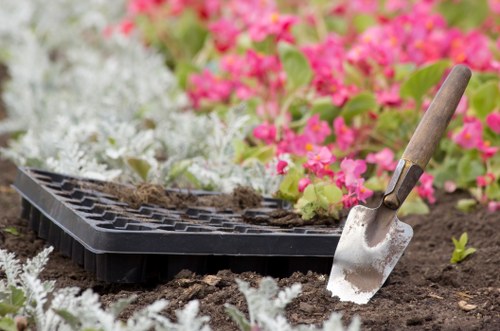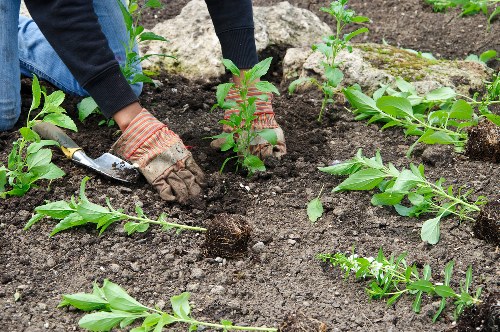Comprehensive Guide to Garden Maintenance in Temple

Introduction to Temple Garden Maintenance
Maintaining a garden in a temple setting is a blend of art and spirituality. The garden serves as a serene backdrop for worship and meditation, providing a peaceful environment for devotees. Proper garden maintenance ensures that the temple grounds remain beautiful, inviting, and conducive to spiritual activities.The primary goal of temple garden maintenance is to create a harmonious space that reflects the sanctity and tranquility of the temple. This involves regular care and attention to various elements such as plants, pathways, water features, and seating areas. A well-maintained garden not only enhances the aesthetic appeal of the temple but also contributes to the overall spiritual experience of the visitors.
In this guide, we will explore the essential aspects of garden maintenance in temples, including plant selection, landscaping techniques, seasonal care, and sustainable practices. Whether you are a temple caretaker or a gardening enthusiast, this comprehensive guide will provide valuable insights to help you maintain a beautiful and spiritually uplifting garden.

Plant Selection for Temple Gardens
Choosing the Right Plants
Selecting the appropriate plants is crucial for creating a serene and vibrant temple garden. The plants should not only thrive in the local climate but also align with the spiritual themes of the temple. Typically, temple gardens feature a mix of flowering plants, shrubs, trees, and ornamental grasses that add color, texture, and fragrance to the surroundings.- Flowering Plants: Marigolds, jasmine, roses, and lilies are popular choices for their vibrant colors and pleasant scents.
- Shrubs: Boxwood, azaleas, and hydrangeas provide structure and greenery throughout the year.
- Trees: Sacred trees like banyan, neem, and peepal not only offer shade but also hold cultural significance.
- Ornamental Grasses: These add movement and texture to the garden, enhancing its visual appeal.
Incorporating Native Plants
Incorporating native plants into the temple garden is a sustainable practice that supports local biodiversity. Native plants are well-adapted to the regional climate and soil conditions, requiring less maintenance and water compared to exotic species. Additionally, they attract local wildlife, including birds and beneficial insects, contributing to a balanced ecosystem within the garden.
Landscaping Techniques for Temple Gardens
Designing with Purpose
The design of a temple garden should reflect its spiritual purpose. Pathways should guide visitors through the garden in a way that encourages reflection and meditation. Strategic placement of benches, water features, and statues can create focal points that enhance the spiritual ambiance.When planning the layout, consider the flow of visitors and how different areas of the garden will be used. For example, quieter corners can be designated for solitary meditation, while more open spaces can host communal activities or ceremonies.
Water Features and Their Significance
Water features like ponds, fountains, or small streams add a soothing element to the garden, symbolizing purity and life. They also help in creating a microclimate that can benefit the surrounding plants. Regular maintenance of water features is essential to prevent stagnation and ensure the water remains clean and clear.
Seasonal Care and Maintenance
Spring Maintenance
Spring is a crucial time for garden maintenance as it marks the beginning of the growing season. Tasks include pruning dead branches, planting new shrubs and flowers, and fertilizing the soil to provide essential nutrients for plant growth.- Pruning: Remove any dead or diseased branches to promote healthy growth.
- Planting: Introduce new plants that will bloom in the upcoming seasons.
- Fertilizing: Apply organic fertilizers to enrich the soil and support vigorous plant development.
Summer Care
During the summer months, focus on watering practices and pest control. Adequate irrigation is vital, especially for plants that are sensitive to heat. Implementing drip irrigation systems can enhance water efficiency and reduce wastage.Regularly inspect plants for signs of pests or diseases and take prompt action to control infestations. Natural pest control methods, such as introducing beneficial insects, can help maintain a healthy garden ecosystem.
Autumn Preparation
As the weather cools, prepare the garden for the dormant season. This includes cleaning up fallen leaves, protecting sensitive plants from frost, and reducing the frequency of watering.- Leaf Cleanup: Remove fallen leaves to prevent fungal diseases and pests.
- Frost Protection: Use mulch or protective coverings to shield plants from cold temperatures.
- Watering Reduction: Gradually decrease watering to prevent root rot during cooler months.

Sustainable Practices in Temple Garden Maintenance
Water Conservation
Implementing water conservation techniques is essential for sustainable garden maintenance. Practices such as rainwater harvesting, using native drought-resistant plants, and mulching can significantly reduce water usage.Rainwater harvesting systems collect and store rainwater for later use, providing an eco-friendly alternative to conventional irrigation methods. Mulching helps retain soil moisture, minimize evaporation, and suppress weed growth, contributing to overall water efficiency.
Organic Gardening
Adopting organic gardening practices ensures that the garden remains free from harmful chemicals, promoting a healthy environment for both plants and visitors. Use organic fertilizers, compost, and natural pest control methods to maintain soil fertility and plant health.- Composting: Convert kitchen and garden waste into nutrient-rich compost to enrich the soil.
- Natural Pest Control: Introduce beneficial insects like ladybugs and praying mantises to manage pest populations.
- Organic Fertilizers: Use manure, bone meal, or other organic fertilizers to provide essential nutrients.
Tools and Equipment for Effective Garden Maintenance
Essential Gardening Tools
Having the right tools is fundamental for efficient garden maintenance. Essential tools include:- Pruning Shears: For trimming and shaping plants.
- Garden Fork: For aerating soil and removing weeds.
- Hose and Irrigation Systems: For providing consistent watering.
- Wheelbarrow: For transporting soil, plants, and other materials.
- Gloves: To protect hands while working in the garden.
Maintenance of Tools
Regular maintenance of gardening tools ensures their longevity and effectiveness. Clean tools after each use to prevent rust and damage. Sharpen blades periodically to maintain cutting efficiency and replace any worn-out parts promptly.Proper storage is also important. Keep tools in a dry, sheltered area to avoid exposure to the elements, which can cause deterioration over time.
Engaging the Community in Garden Maintenance
Volunteer Programs
Involving the local community in garden maintenance fosters a sense of ownership and responsibility. Organize volunteer programs where community members can participate in planting, weeding, and general upkeep of the temple garden.- Workshops: Conduct gardening workshops to educate volunteers on effective maintenance techniques.
- Community Events: Host events like planting days or clean-up drives to engage more people.
- Recognition: Acknowledge and appreciate the efforts of volunteers to encourage continued participation.
Educational Initiatives
Educational initiatives can enhance the community’s understanding of the importance of garden maintenance. Provide informational brochures, conduct seminars, and create informative signage within the garden to educate visitors about the plants, landscaping, and sustainable practices employed.Collaborate with local schools and organizations to involve students and youth in gardening activities, promoting environmental stewardship from a young age.
Integrating Technology in Garden Maintenance
Smart Irrigation Systems
Utilizing technology can streamline garden maintenance tasks. Smart irrigation systems automatically adjust watering schedules based on weather conditions and soil moisture levels, ensuring optimal water usage and plant health.These systems can be controlled remotely via mobile devices, providing flexibility and convenience for temple caretakers. Additionally, they offer data analytics to monitor water consumption and identify areas for improvement.
Garden Management Software
Garden management software helps in planning, tracking, and managing maintenance activities. Features include scheduling tasks, inventory management for plants and supplies, and monitoring plant health through data collection and analysis.- Task Scheduling: Assign and track maintenance tasks to ensure timely completion.
- Inventory Management: Keep track of plants, tools, and other resources required for garden maintenance.
- Data Analytics: Analyze plant growth patterns and maintenance efficacy to make informed decisions.
Challenges in Temple Garden Maintenance
Climate and Weather Variability
Unpredictable weather patterns can pose significant challenges to maintaining a temple garden. Extreme temperatures, heavy rainfall, or drought conditions can affect plant health and require adjustments in maintenance practices.Implementing resilient landscaping strategies, such as using drought-resistant plants and proper drainage systems, can help mitigate the impact of adverse weather conditions.
Pest and Disease Management
Pests and diseases can quickly spread, damaging plants and disrupting the garden’s harmony. Early detection and prompt action are essential to control infestations and prevent widespread damage.- Regular Inspections: Conduct routine checks to identify signs of pests or diseases early.
- Integrated Pest Management: Combine biological, cultural, and chemical methods to manage pest populations sustainably.
- Healthy Plant Practices: Promote strong plant growth through proper fertilization and care to resist pests and diseases.
Resource Constraints
Limited financial and human resources can hinder effective garden maintenance. It is important to prioritize maintenance activities, seek community support, and explore cost-effective solutions to manage the garden efficiently.Applying sustainable practices and leveraging volunteer efforts can help overcome resource limitations while maintaining the garden’s beauty and functionality.
Benefits of Well-Maintained Temple Gardens
Enhanced Aesthetic Appeal
A well-maintained garden significantly enhances the visual appeal of the temple, creating an inviting atmosphere for visitors. The vibrant colors, lush greenery, and thoughtfully designed landscapes contribute to the overall beauty and serenity of the sacred space.- Attracting Visitors: A beautiful garden attracts more visitors, increasing the temple’s reach and influence.
- Promoting Tranquility: The aesthetic elements of the garden provide a calming environment conducive to meditation and worship.
- Symbolic Significance: Gardens often symbolize purity, growth, and the cyclical nature of life, aligning with the spiritual themes of the temple.
Environmental Benefits
Temple gardens contribute to environmental sustainability by supporting biodiversity, improving air quality, and providing habitats for various wildlife species.Plants absorb carbon dioxide and release oxygen, helping to mitigate air pollution. Additionally, gardens can serve as green spaces that offer cooling effects in urban areas, contributing to the well-being of the community.
Social and Spiritual Impact
Gardens serve as communal spaces where people can gather, interact, and engage in spiritual activities. They provide a peaceful retreat from the hustle and bustle of daily life, fostering a sense of community and spiritual growth.- Community Engagement: Gardens encourage communal activities and foster a sense of belonging among visitors.
- Spiritual Enrichment: The serene environment of a garden enhances meditation and prayer, deepening the spiritual experience.
- Educational Opportunities: Gardens offer a platform for educating visitors about horticulture, sustainability, and the cultural significance of plants.
Conclusion
Maintaining a garden in a temple is a rewarding endeavor that combines horticultural skills with spiritual dedication. A well-maintained temple garden not only beautifies the sacred space but also enhances the spiritual experience of its visitors. By carefully selecting plants, employing effective landscaping techniques, adhering to seasonal care routines, and embracing sustainable practices, temple gardens can thrive and remain a source of inspiration and tranquility.Engaging the community and leveraging technology can further enhance garden maintenance efforts, ensuring that the temple grounds remain vibrant and welcoming for generations to come.
Contact us today to learn more about our garden maintenance services and how we can help you create a beautiful and serene temple garden.

